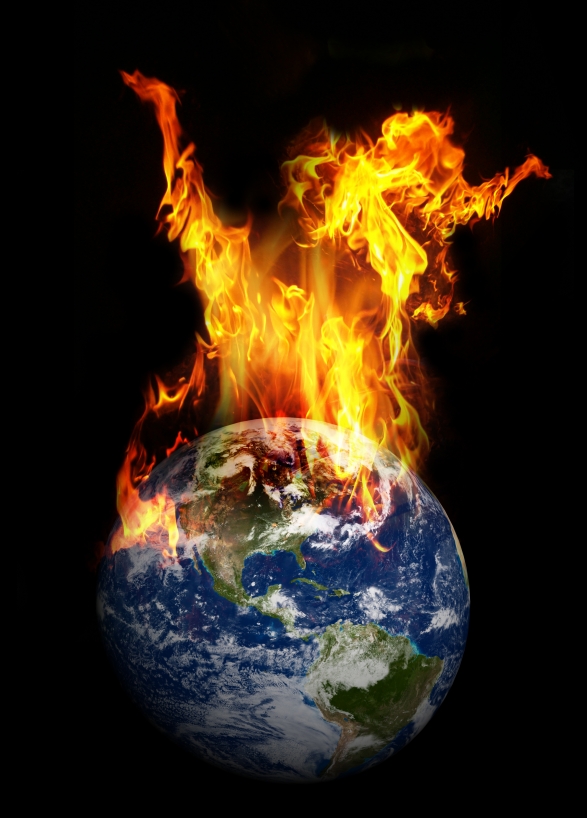If human civilization as we know it is dependent on the maintenance of the stable climate in which it evolved over the past 10,000 years, then we are well and truly @#$%ed.
Tuesday’s election results mean it is now virtually impossible to avoid exceeding the targets set forth by the U.N. for “safe” levels of climate change. This election looks to be a turning point down the long dark road to the collapse of planet’s cryosphere.
From here on out, we are mitigating our emissions of greenhouse gases not because we think it’s possible to avert catastrophe, but because we are attempting to avert a worse catastrophe.
It’s the scenario outlined by a seminal 2009 paper in the world’s top scientific journal, Nature: “Overshoot, adapt and recover.”
As Obama’s science advisor John Holdren put it:
We basically have three choices: mitigation, adaptation and suffering. We’re going to do some of each. The question is what the mix is going to be. The more mitigation we do, the less adaptation will be required and the less suffering there will be.
Many scientists have already been arguing that the window of opportunity for a largely mitigationist climate strategy has closed — and yesterday’s election underscores that point.
The countless climate zombies elected to Congress have promised legislative gridlock and even trials of climate scientists, virtually guaranteeing that we will have no substantive national laws aimed at curbing climate change for at least the next two years.
The election of climate zombie governors who will be responsible for congressional redistricting will make it even harder to get climate hawks into Congress in the future.
There are ways out of this conundrum, of course: The EPA could ride to the rescue. A series of “climate change Pearl Harbors” could trigger a political tipping point that convinces U.S. (and world) leaders to make mitigation efforts their top priority.
But even if we shut down 100 percent of the world’s sources of greenhouse gas emissions today, we are still committed to 2.4 degrees C (4.3 degrees F) of warming by the end of the century, says NASA’s James Hansen.
Hansen also argues that the slow feedbacks resulting from this degree of warming will, over the course of centuries, lead to the complete collapse of the Earth’s cryosphere — in other words, Greenland and the southern ice cap. Antarctica, to give you a sense of its scale, is a continent one and a half times as large as the United States, its surface 99 percent covered with ice up to three miles deep. The paper Geoengineering: The Inescapable Truth of Getting to 350 (which is both unusually readable and open access) puts it this way:
To describe future climate change as catastrophic may sound alarmist; however, warming Earth’s climate to a point that it can no longer sustain the planet’s cryosphere demands the use of such strong language.
With the cryosphere’s collapse, global sea level will rise by greater than 80 meters (262 feet), inundating coastal plains and low-lying islands around the world. Over a billion people will be displaced to higher ground, amplifying the other impacts of climate change such as extreme weather events, floods, and droughts. While the Earth system has experienced comparable cataclysmic events during its evolution, human civilization certainly has not.
Everyone who has a horse in this race wants to constrain the parameter space that encompasses possible futures according to their own particular beliefs: Some, like James Hansen, argue that a hard cap on emissions is what the uncompromising laws of physics demand. Others, like The Breakthrough Institute, Bill Gates, and Roger Pielke Jr., favor technological solutions, and seem to be arguing that innovating our way out is the only solution possible given the limits of human nature. Still others, mostly economists, cling to the belief that the world economy will continue to expand at a rate that will obviate the need to solve climate change with anything beyond our enormous wealth.
Yet the reality is that every one of these proposed solutions is in tatters: The momentum behind a climate bill is gone, and international negotiations over emissions targets are mired in a tussle between the U.S. and China (or the developed and the developing world). No technological quick fix is on the horizon. And an economy that’s down despite an ever-increasing supply of both workers and productivity seems to give the lie to the notion of permanent growth.
Still, we have to commit to all of these solutions, and aggressively pursue adaptation too. Every bit of energy infrastructure we build that is designed to mitigate carbon emissions will also have to take into account the changing weather patterns of the future. Cities will have to not only reduce their carbon footprint but increase their resilience in the face of extreme weather and hydrological crises of every variety.
The anthropocene — the era in which the earth’s biosphere is dominated by a single hominin species: us — will be characterized by a battle between competing interests of Tolkienesque proportions, followed by transitions of a scale and nature we can scarcely imagine at present.
Especially when many of our leaders have yet to even show up for the contest.



